|
Monday, December 27, 2010
Progress Notes
Clyde Lee Jenkins (photo 01) in his book, History of Miller County, discusses one of the public celebrations regularly held in Tuscumbia in the early 1800’s named the Militia and Muster Day.
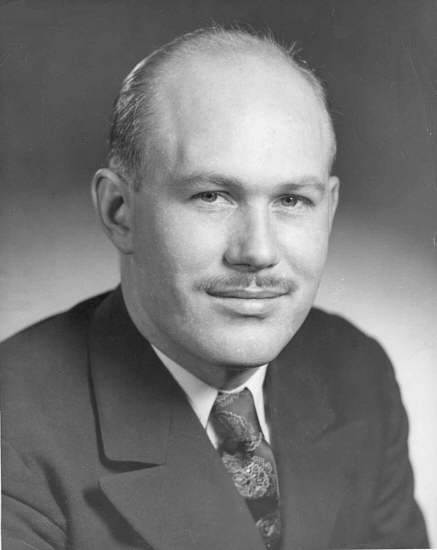
01 Clyde Lee Jenkins The following excerpt about Muster Day is copied here:
Militia and Muster Days
Judge Jenkins History of Miller County p. 127
In 1837, the year Miller County was organized, the inhabitants were exposed to imminent peril. The Osage Indians, having of a sudden made an unexpected inroad into Southwestern Missouri, were on the warpath. Unable to summon the military force of the United States in time to meet the danger, the Governor ordered a portion of the militia into the field, the only other resource for defense. The savages were repelled happily without much injury.
Fear of a massacre continued on every mind until volunteers in the Big Richwoods in September, 1839, organized the Miller County Militia. On October 26, 1839, the company crossed the river to Muster Day at Tuscumbia. William C. Neely was allowed $10.37 by the State Auditor for the ferriage of this company across the Osage River.
At the ferry landing, on the north bank of the river, under the hill at the County Seat, Colonel Abraham Castleman, Captains John Bond and William P. Dixon, led the men, dressed in buckskin breeches and leather hunting coats, each man carrying his own Kentucky long rifle, in an impressive parade (photos 02, 03 and 04).
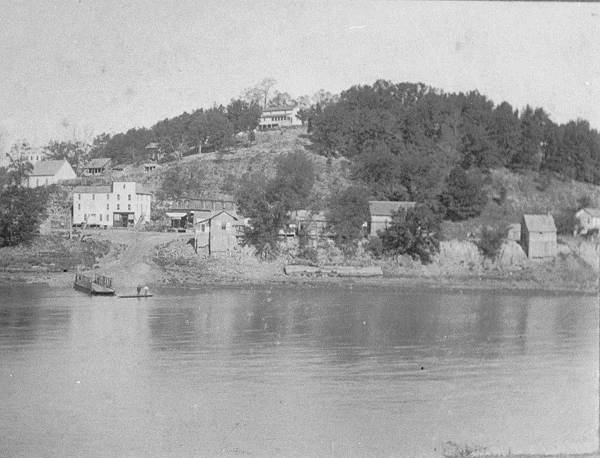
02 Ferry Landing at Tuscumbia looking north across the River
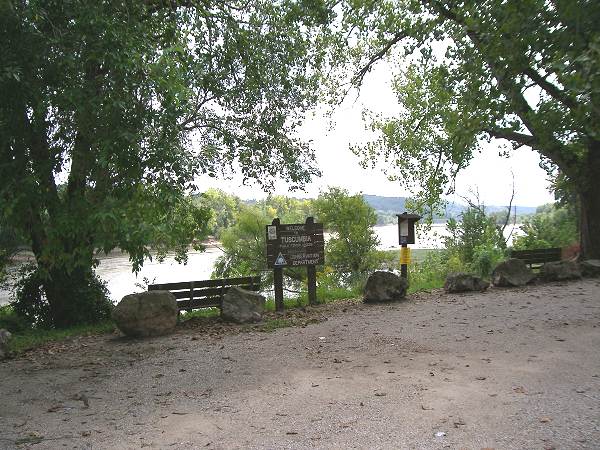
03 Present day photo of Ferry Landing from North side of River
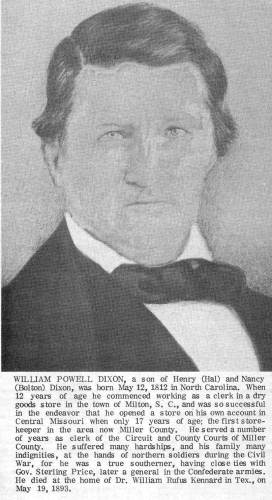
04 William Powell Dixon
Click image for larger viewFrom 1804 to 1847, free white males in Missouri of 18 to 45 years of age were compelled to attend muster. Military drills of short duration were held, but military discipline was very lenient. After dismissal, shooting exhibitions were held, games of skill contested, and feats of great physical strength displayed. Corn liquor, available from big barrels, was consumed freely by everyone, until mashed and broken noses were the order of the day. However, liquor could not be possessed or sold on the parade ground.
In a free for all fight, at the August muster, in 1844, at Tuscumbia, James Lamma was killed.
The militia served a very real need in earlier days when the stealing of a horse was the greatest known crime. It provided a means of training scouts who could follow the tracks of a horse or the footprint of a person like a hound following a rabbit.
Muster day also was a time for addresses, public announcements, and proclamations. Local politicians often addressed the companies after dismissal. The County Court, having appointed John T. Davis, Commissioner, on May 8, 1844, to superintend the working of the main street in Tuscumbia, ordered Captain Davis to give notice of the letting of this work at the Battalion Musters.
On the first Monday in June, 1844, Captain Davis proceeded to give notice as ordered by the Court, and Colonel Abraham Castleman, bidding the project lowest, at $135.50, solicited militia men to help in the work. Enough of the men coming forward completed the project by January 1845. The street up the hill, from Dixon’s stable to the Courthouse, was widened.
In the winter of 1844, Major Josiah Birdsong, with a company of militia, took after a group of outlaws, passing through Miller County appropriating horses, and other necessaries for sustenance. Near the Saline Creek, the militia were surrounded, and ambushed. A lively gun battle ensuing, the Major was shot from his horse. Major Birdsong, although conscious when found by his men, was in such a weakened condition he could not rise, his own blood having frozen his clothing to the ground. For this feat of daring the Major was promoted to Colonel; afterward known as Colonel Birdsong until his death.
In 1846, Muster Days were held at Tuscumbia on May 30, June 13, and July 11.
On May 30, the militia assembled at the County Seat about one hundred strong. On horseback, and in full dress, they paraded by the General’s Stand, under the command of Colonel Abraham Castleman; Captain John T. Davis; Lieutenants Champ Smith and Peter Bilyeu.
On June 13, the militia, when dismissed at high sun, were addressed by Generals George W. Miller and Thomas L. Price of Jefferson City.
Again at Tuscumbia, on July 11, the militia paraded under Colonel Josiah Birdsong; Captains John T. Davis and William P. Dixon; Lieutenants Champ Smith and Peter Bilyeu. When dismissed at high sun, each man fired his musket, imitating “the blaze of glory” of the Volunteers for the Mexican War, mustered seven days before, in an Independence Day celebration, at the big spring.
On November 4, 1846, Snelling and Poor, ferrymen at Tuscumbia, were allowed $14.90 by the Miller County Court for crossing the militia over the Osage River; and on November 5, Hugh Snelling was allowed an account against the State for services as ferryman in crossing the Miller County Militia over the Osage River at Tuscumbia, on Muster Days of May 30, June 13, and July 11, 1846.
Muster Day, held at Tuscumbia the last time in the Summer of 1847, was a scene of pomp and ceremony, attended by citizens from every township. In splendid form the militia paraded; and when finished, troops were drawn up in formation. After announcements and orders were given, the Miller County Militia was disbanded.
Note: the following two sketches depicting scenes from Muster Day were copied from Judge Jenkins’ book (photos 05 and 06).
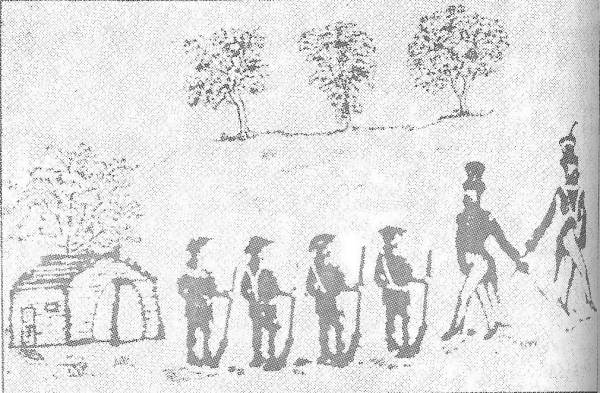
05 Muster Days in Tuscumbia from Jenkins Narrative
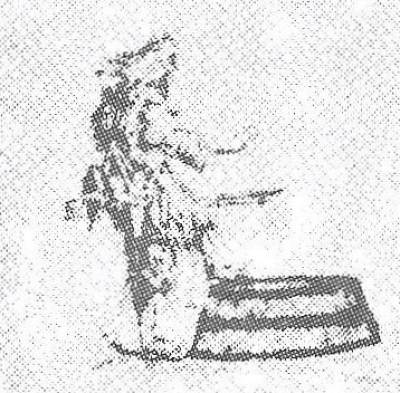
06 Pioneer Hunter at Muster - From Jenkins An Act of the Legislature, approved March 3, 1851, ended the local force for all time. This act required the County Courts to apportion the military fund belonging to their counties, among the different school townships, in proportion to the number of children in each township, over the age of five years and under twenty, for the purpose of education.
After the Militia ceased to exist, Patrol Companies were organized. On August 3, 1847, a Patrol Company was appointed by the Miller County Court for Saline Township, with Joseph D. Taylor, Captain; Elijah Spence, Stephen Routen, George C. Adcock and William GT. Burks, patrol members. They were ordered by the County Court to patrol in Saline Township no more than 24 hours, nor less than 12, in each month. This patrol was probably established because of the excitement over the Mexcan War, but its main function was “nigger watching” (quote from county records).
One of the people mentioned in Clyde’s narrative above was of one of the most important early Miller County citizens, Champ Smith (photo 07).
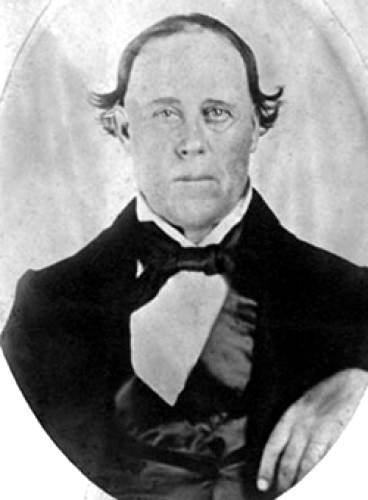
07 Champ Smith Champ was the son of the Revolutionary War soldier, Charles Smith, whose tombstone is located in the Hawken Cemetery, three miles east of Tuscumbia (photo 08).
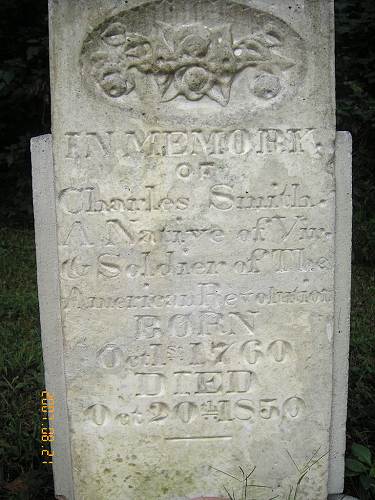
08 Charles Smith Tombstone
Click image for larger viewChamp Smith was born in 1810. He was sheriff of Miller County from 1852 to 1856. He served as a Lieutenant in the Mexican War.
But before discussing Champ’s story further, I am placing Peggy Hake’s biography of both Champ and Charles Clark here, taken from our own website:
CHARLES SMITH, REVOLUTIONARY WAR SOLDIER
On Sunday afternoon, Feb. 28, (1999), I was invited to attend the memorial and grave marking ceremony for a Revolutionary War soldier named Charles Smith who was buried at Jesse Hawken Cemetery about a mile northeast of Tuscumbia. It was a beautiful and impressive service sponsored by the Daughters of the American Revolution, Eldon Chapter. There were seven descendants of Charles Smith in attendance. Most came from Texas to attend the special ceremonies. The crowd was very large in number, which was a fitting tribute to an old solider who has been buried on a lonely hillside overlooking the Osage River for almost 150 years. I would like to tell you his story....................
Charles Smith, a Revolutionary War soldier, was a son of Josiah and Elizabeth Smith and he was born 1 Dec 1760 in Albemarle Parish, Sussex County, Virginia. His ancestry has been traced back into the 1600s in England by some of his descendants. Their ancestral line goes back to a Sir Thomas Smith who was a treasurer for one of the kings of England. The ancestors of Charles Smith were among America's early colonists.
Charles Smith married Mary Pemberton in Green County, Kentucky on 26 Jan 1808. I believe she was his second wife. She was born 26 July 1786, probably a daughter of George Pemberton. There were several years of difference in their ages and it is likely he had older children by a first wife. It was speculated for awhile that his first wife was named Nancy Johnson, but that did not prove correct when it was learned the husband of Nancy was indeed named Charles Smith, but he died in Tennessee in the 1840s.
In 1808, Charles Smith paid taxes on property in Wilson County, Tennessee and later lived there because he was in Wilson County during the census of 1820, 1830, and 1840. Wilson County is in north central Tennessee directly east of Davidson County (Nashville).
Charles petitioned for a pension as a veteran of the Revolutionary War in June 1829 while living in Wilson County, TN. He stated he had been a trumpeter for the Continental Army under the command of Col. William Washington of the Virginia Line. He had been a militiaman at Gates' defeat at the Battle of Cowpens (today located in Cherokee County, South Carolina). In 1841, Charles gave notice he would be moving to Missouri with his son, Champ Smith, and wanted his pension ($10 per month) to be sent to Tuscumbia, Miller County, MO. According to an affidavit he signed, they moved to Tuscumbia in June, 1842.
NOTE: One researcher believes that Champ Smith's name was actually Beauchamp. The English version of Beauchamp is Beecham. Champ's wife, Martha, is buried at Jesse Hawken cemetery beside her father-in-law, Charles, and on her stone is carved: Martha Smith, wife of B. (which could be Beauchamp).
In August 1841, both Charles and Champ Smith sold their land on Fall Creek in Wilson Co., TN. They may not have come to Miller County immediately after the sale because Charles stated in the affidavit (mentioned above-dated Nov 1842) that they had been in Miller County for almost five months.
The children of Charles and Mary (Pemberton) Smith were:
- Champ Smith b. c/1810 m. Martha W. Sellars in Wilson Co., TN 26 Jul 1831
- Eliza Smith b____ m. William C. Sellars Sept 1837
- George Smith b.____ (his descendants went to Texas)
There may have been another daughter named Mary Smith who married James C. Bone in Tennessee…............I would imagine there were older children born to a first wife but no record has been found naming other children.
William C. Sellars, son-in-law of Charles, was in Miller County, MO in January 1843 when he and Champ Smith signed an affidavit for Charles…....Charles died in Miller County on 20 Oct 1850 at the age of 90 years. I believe his wife, Mary (Pemberton) died in Tennessee before the family moved to Missouri and is probably buried in Wilson County.
Champ Smith, son of Charles, continued to live in Miller County until just prior to 1860 and at that time he moved his family to Texas County, MO. They appear in the census of 1870 in Texas County, but do not appear in 1880. I don't know what happened to him and his family after that. Perhaps they moved to the state of Texas where the family of his brother, George Smith, had located…....I haven't figured out why Champ's wife, Martha Sellars Smith, is buried at Jesse Hawken cemetery in Equality township since she died in 1871….perhaps Champ did not leave the area until after Martha died?
It has been said that the D.A.R. (Dau. of Am. Revolution), Jefferson City Chapter, marked the gravesite of Charles Smith many years ago, but no records has been found. There is an old tombstone lying on the ground at his burial site with his name and military information engraved on it. I do not know who placed the old stone there.
The following is a compilation of the references to Champ Smith found in Clyde Lee Jenkins’ History of Miller County:
p. 199:
Green B. Coggburne, in 1852, was a merchant at Fair Play, but ceased mercantile pursuits the following year. He was levied upon for debts, Sheriff Champ Smith removing, storing, invoicing, and selling his goods and chattels at considerable expense in October, 1853.
p. 224:
List of slave owners.
Champ Smith: 1 slave valued at $1,000
p. 225:
Charles Smith, on December 5, 1843, stated “for the sum of 2 dollars, I hereby sell unto my son, Champ Smith, my mulatto slave Andrew, but to remain in my possession during my natural life.”
p. 229
List of slave owners in 1860 and their slaves total valuation from the Assessor’s book:
Champ Smith: 1 slave assessed at 900 dollars.
p. 235
In January, 1849, Bob Wilson, a fiery preacher of the Methodist Episcopal Church, arrived at the Courthouse, in Tuscumbia, to preach on the evils of slavery. His assistant, a young man in his early twenties, spread word of the meeting throughout the village.
Nearing the appointed hour, an immense crowd of angry citizens were under the hill, having gathered in the dram shops. Daniel Cummings, noticing the people’s temper, believed the abolitionist preacher would be lynched, which should happen to no Methodist!
Daniel Cummings, with Champ Smith beside him, hastening up the hill, entered the Courthouse, informing preacher Wilson if he started preaching, the people would kill him. They persuaded Wilson to leave, but his young assistant remained behind.
This young man was handsome; having a fine open forehead. His hair and complexion were fair; his air and carriage very commanding. He was possessed of great courage, yet this youth, with all his fine qualities, was the occasion of infinite hatred to many of the mob.
When the crowd arrived on the hill the youth was seized, man handled, and tied to a pot in front of the Courthouse. His shirt was torn off, and there were cries of “Burn him at the stake!” Champ Smith, grabbing a cat o nine tails, a whip, viciously popped it a few times, which quieted the crowd.
In a low voice, he calmly told the youth something had to be done or the crowd would take his life. Smith handed the whip to Sheriff S.C.H. Witten, who administered twenty lashes upon the bare back of the youth.
The mob, satisfied, dispersed.
p. 245:
The sixth school house in Miller County was raised near the Osage River by the mouth of Gum Creek. In 1843 a summer term of school was taught. In 1855 this building was abandoned with school held and taught in a building at Tuscumbia, raised for school purposes, and privately owned by Daniel Cummings and Champ Smith.
p. 244:
On September 22, 1849, the inhabitants of Congressional Township School district Number 4, met at the house of John W. Johnston, near the ‘Saline Creek, at ten 0’clock in the forenoon, and organized the township for school purposes pursuant to the law of 1845. The County Court appointed John W. Johnston, Commissioner; Champ Smith and John Stapp, inspectors of the common schools in the district.
p. 247:
First School Commissioner:
Thomas J. Marshall was the first School Commissioner of Miller County. This was the infant beginning of the County Superintendency of schools.
Marshall was appointed as school commissioner by the County Court on November 9, 1853 for a term of two years. The same day Commissioner Marshall presented to the Court his official bond with Abraham Castleman, Emanuel Godlove, and Champ Smith as securities, conditioned for the faithful performance of his duties, in a sum of $2,000. Commissioner Marshall received $119 for his services in the year of 1855. He served in the office until 1858, then E.B. Farley, County clerk, assumed the duties of school commissioner. William M. Lumpkin replaced Farley in 1860.
p. 263:
The first church house in Tuscumbia, a Methodist building, was erected by Champ Smith, in February, 1860. This house of worship was situated on lots numbered 7 and 10, block 36, and was erected for $99.61.
p. 337:
In 1856, Champ Smith and Daniel Cummings erected a log school building having a puncheon floor and a stone fireplace. The building and grounds were purchased from them by the school district in 1857 for $112. The first teacher at this school was Edward A. Henry, of Pleasant Mount.
p. 338:
On December 21, 1852, the County Court appropriated a sum of $150 for building a bridge across the Shut In Branch in Tuscumbia, with Champ Smith appointed Commissioner to let out, and oversee construction. This was the first bridge in Tuscumbia across Shut In Branch, situated under the hill, near the Big Spring, in Tuscumbia (photo 09).
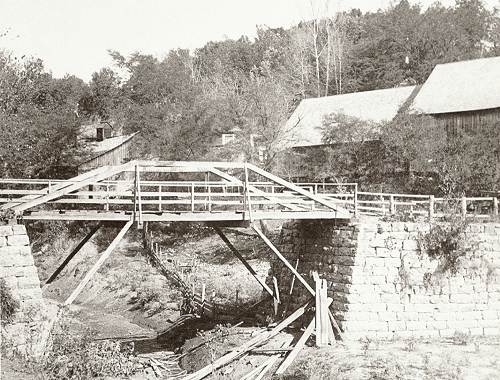
09 Bridge across Shutin Branch
Click image for larger viewp. 343:
In February 1860 a Methodist Church house was built in Tuscumbia by Champ Smith. This church house, a frame building, was erected on lot numbered seven and ten, in block number 30. Its erection cost ninety nine dollars and sixty one cents. Members of the church board of Trustees were John D. Reed, James Johnston, Robert H. Davis, John H. Melton, J.B. Challes, Abraham Casey, and Champ Smith.
This was the first church building in Tuscumbia; the congregation was immediately disrupted by Civil War. From then until October 1888, Tuscumbia was the only county Seat in the State of Missouri, without a church house. However, religious services were held in the Courthouse and other buildings.
In summary, Champ Smith is recorded by Clyde Lee Jenkins as having the following activities or accomplishments ascribed to him:
- Miller County Sheriff
- Community organizer and interventionist (especially regarding his saving the Methodist preacher from a hanging)
- Participated in the development of the educational system of the county
- Built the first church in Tuscumbia (Methodist)
- Built the first school building in Tuscumbia
- Supervised the construction of the first bridge in Tuscumbia
Readers may not have heard of Champ Smith before, or perhaps knew little about him. He lived here long ago and then left for Texas County, Missouri in 1860, so it is understandable why some may not have known about him as one of Miller County’s most important early figures. And since no photographers were around in those early days, we have only a few photographs to accompany this narrative.
Some may question why Champ Smith had a slave and just one, no more. The records show that the slave was left to him by his father, Charles. In those days, sometimes people came into the possession of a slave but did not necessarily treat the individual as a slave. Another instance of an unlikely slave owner is Emly Golden, who was a fierce supporter of the North in the Civil War. The record of Emly purchasing a slave was found recently in our review of the Probate Files where, in the file for Benjamin Hinds, the list of purchasers reveal the name of Emly. Here are photos of the original pages of that sale (photos 10 - 13).
Click on any of the thumbnails to view a larger image.
Note: Once you click on an image below, a new window will open. It would be best to maximize this new window by clicking on the middle box in the upper right-hand corner of the window. When you move your cursor over the image in this new window, it will change to a magnifying glass. Once this occurs, click on the image and it will show in a larger format for easier viewing.
Miller County historian, Gerard Schultz, recorded some of the details of this sale in a book he wrote about the history of the enslavement of black people not only in Miller County but the general area of the northern Ozarks. The book was titled, “Early History of the Northern Ozarks,” published in 1937. I referred to that book in a previous Progress Notes about slavery.
Copied here is the short narrative Gerard wrote about the sale:
“Slave auctions held in connection with the disposal of the personal property of a deceased slave owner were not at all uncommon. In Miller County in 1859 five of the eighteen slaves belonging to the estate of Benjamin Hinds were given to Jane Hinds, his widow. The county court ordered the other slaves to be sold at public auction on January 10, 1860, at the late residence of the deceased. The time, terms, and place of sale were to be advertised in the Jefferson Examiner and the California News for two successive weeks. Similar announcements of the sale were to be posted in six public places in the county. The sale took place on the day designated. The table below lists the slaves sold, their ages, purchasers, and the appraised value of the slaves at the time of the partition of the estate, and the purchase price (photo 13a)."
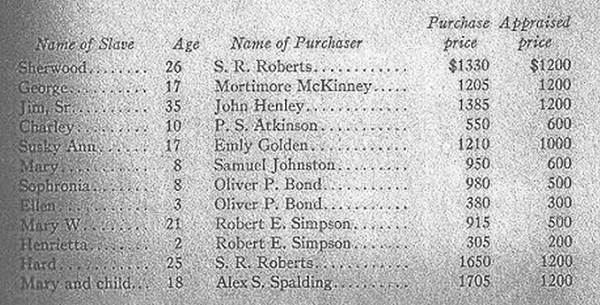
13a Slave Sale Table In summary of what is written above, we recognize and appreciate the contribution of Champ Smith and his father, Charles Smith, to the history and development of our county. However, the relocation of the Champ Smith family to Texas in 1860 has left a void which makes for an incomplete ending to this story of one of Miller County’s most important early figures.
The slave owner Benjamin Hinds mentioned above was the head of an important Miller County family. We don’t have a biography of him on our website but you can learn some interesting information about him at this genealogical website.
Last week author Dan Peek held another book signing of his recently released book, Ozark Opry Live, at the Downtown Book and Toy Store in Jefferson City (photos 14 and 15).

14 Daniel Peek
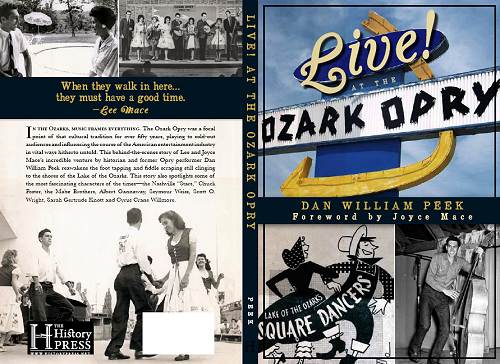
15 Ozark Opry Live Book Cover
Click image to view larger version in PDF formatThe shoppers who came to the store were entertained by previous Ozark Opry performers Bill “Goofer” Atterberry, LeRoy Haslag, and Jim Phinney. Also joining in was Howard Marshal (photos 16, 17 and 18).
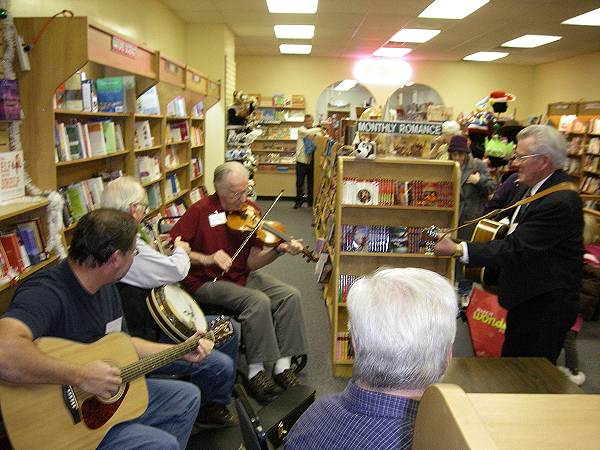
16 Dan Peek, Jim Phinney, Howard Marshall, LeRoy Haslag and Bill Goofer Atterberry
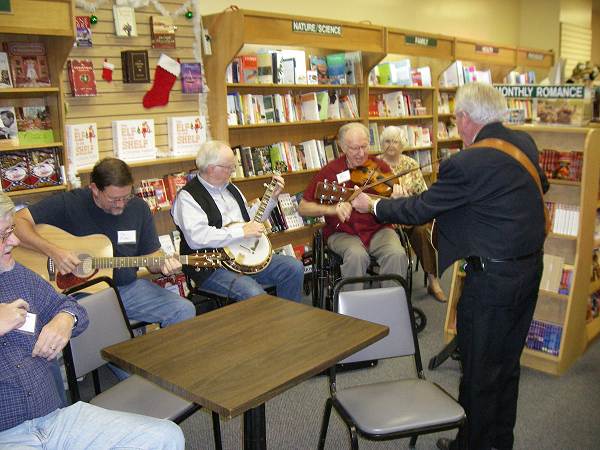
17 Dan Peek, Jim Phinney, Howard Marshall, LeRoy Haslag and Bill Goofer Atterberry
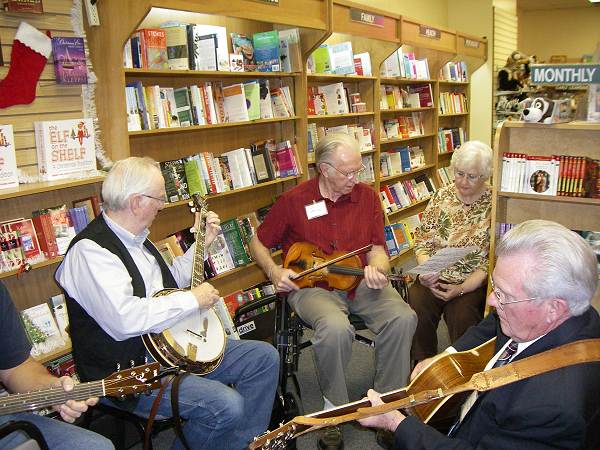
18 Howard Marshall, Mr. and Mrs. LeRoy Haslag and Bill Atterberry The book recently was sold out already at local stores but more were coming in and should be available now. I found the book very well written including much first person documentation by many of the early Opry performers and others who were part of the Opry team. Dan has made the book really authentic because he interviewed personally all the major performers and other key individuals making sure that the book accurately tells the Opry story.
Dan recently managed to find an old 1955 wire recording from one of the earliest Ozark Opry radio shows on KRMS Radio of Osage Beach. He loaned it to us to reproduce on the website this week.
Performers who are heard on the recording include Dale Sled on Dobro, Bob McCoy on guitar and vocals, Billie Moore on fiddle, and Lonnie Hopkins on banjo.
Here is a photo of this early Opry group (photo 19):
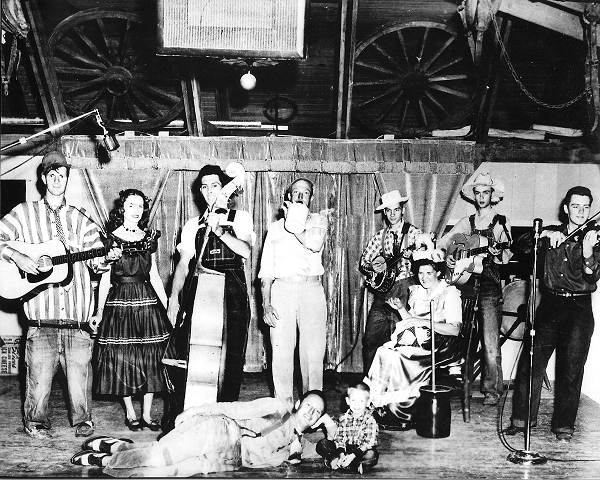
19 First Opry Group:
Bob McCoy, Ramona Bullington, Lee Mace, Basel Robinette,
Lonnie Hopkins, Bob Pesky, Ozark Annie and Billie Moore
Click image for larger viewYou can listen to the radio show here (running time 19mins 41secs):
Dan’s book can be obtained online from Barnes and Noble and Amazon.com.
Here is a photo of Lee Mace taken in the early 1960’s (photo 20):
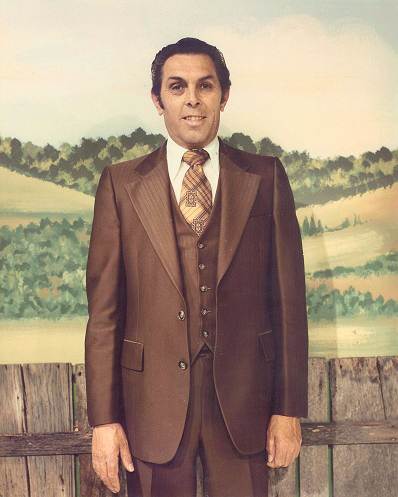
20 Lee Mace You can read more about Lee Mace and the Opry at this previous Progress Notes.
And you will find many photos of the Ozark Opry musical group over the years at the Opry homesite.
That’s all for this week.
 Joe Pryor
Previous article links are in a dropdown menu at the top of all of the pages.
|

